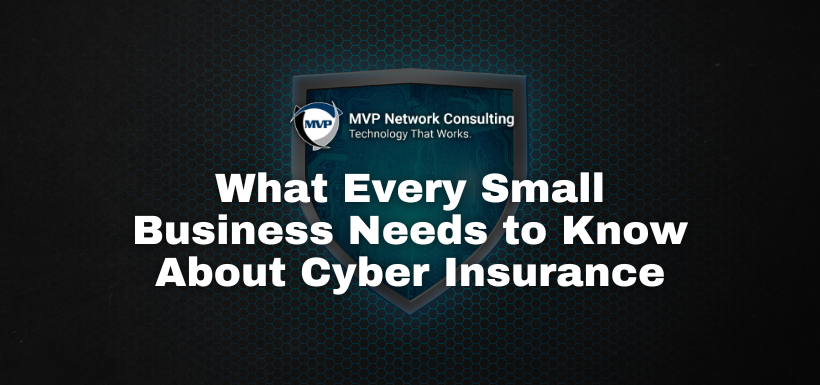What Every Small Business Needs to Know About Cyber Insurance

Ikram Massabini
July 22, 2025

For small businesses navigating an increasingly digital world, cyber threats aren’t just a distant possibility—they’re an everyday risk. From phishing scams and ransomware to accidental data leaks, the potential financial and reputational damage is significant.
That’s why more companies are turning to cyber insurance to help reduce their exposure and ensure faster recovery after an incident.
But not all policies offer the same level of protection. Many business owners assume they’re covered, only to discover critical gaps after it’s too late. In this article, we’ll break down what cyber insurance typically covers, where it falls short, and how to choose the right policy for your business.
Why Cyber Insurance Is More Essential Than Ever
You don’t need to be a large corporation to attract cybercriminals. In fact, 43% of all cyberattacks now target small and midsize businesses (IBM, 2023). The average cost of a data breach for a smaller company? Nearly $3 million.
Beyond the financial impact, customers expect their data to be handled securely. Regulatory bodies are also increasing enforcement of data privacy laws like GDPR, CCPA, and HIPAA. A good cyber insurance policy not only helps cover breach costs but can also help with compliance and legal defense.
What Cyber Insurance Typically Covers
A strong policy provides first-party and third-party coverage—each protecting different parts of your business in the event of a cyber incident.
#1 First-Party Coverage
This protects your business directly from the immediate impact of a cyberattack.
Breach Response Costs
Covers forensic investigation, legal consultation, notification to affected customers, and credit monitoring services.Business Interruption
Reimburses lost revenue from downtime caused by attacks.Cyber Extortion and Ransomware
Covers ransom payments, negotiation services, and data recovery.Data Restoration
Helps recover or replace lost/damaged digital assets.Reputation Management
Includes PR services and communication strategies to rebuild trust post-breach.
#2 Third-Party Liability Coverage
This covers legal and regulatory costs if a breach affects your customers, vendors, or partners.
Privacy Liability
Covers lawsuits and damages related to the exposure of sensitive customer data.Regulatory Defense
Helps pay for fines, penalties, and legal defense related to data protection violations.Media Liability
Protects against lawsuits stemming from online defamation, intellectual property issues, or data leaks caused by the attack.Defense and Settlement Costs
Covers attorney fees and settlements if you’re sued over a cyber incident.
#3 Optional Riders and Custom Coverage
Cyber insurance can be customized to your business’s specific risk profile.
Social Engineering Fraud
Covers losses from phishing, impersonation, and email scams.Hardware Bricking
Replaces devices damaged beyond repair due to malware or destructive attacks.Technology Errors and Omissions (E&O)
Protects service providers and developers from liability due to technical mistakes.
What Cyber Insurance Often Doesn’t Cover
Knowing what’s not covered is just as important as knowing what is. Many businesses are caught off guard by these common exclusions:
#1 Negligence and Poor Cyber Hygiene
If you don’t maintain basic security measures (e.g., MFA, firewalls, patching), your claim may be denied.
Pro tip: Insurers increasingly require proof of cybersecurity practices before issuing a policy.
#2 Known or Ongoing Incidents
Attacks or breaches that began before your policy started are generally not covered.
Pro tip: Secure your systems and address any known vulnerabilities before applying for coverage.
#3 Nation-State or State-Sponsored Attacks
Many policies exclude attacks attributed to government-backed actors, treating them as acts of war.
Pro tip: Carefully review any “war exclusion” clauses and ask how they apply to cyber incidents.
#4 Insider Threats
Malicious actions from employees or contractors are not always covered unless explicitly included.
Pro tip: Consider adding insider threat protection if this is a concern for your business.
#5 Long-Term Reputational Harm
Policies often cover crisis communication but not the future loss of customers or sales due to damaged trust.
Pro tip: Invest in strong brand management and consider additional crisis support services.
How to Choose the Right Cyber Insurance Policy
#1 Assess Your Business Risk
Start by evaluating:
The types of sensitive data you store (customer, financial, health).
Your reliance on digital tools or cloud platforms.
Whether third-party vendors access your systems.
This risk profile will help you identify what kind of coverage you need most.
#2 Ask the Right Questions
Before signing a policy, ask:
Does this cover ransomware, phishing, and social engineering attacks?
Are legal fees, settlements, and regulatory fines included?
What exactly is excluded—and under what circumstances?
#3 Get a Second Opinion
Work with a cybersecurity consultant or broker who understands the technical and legal nuances. They can help you identify policy gaps and find the best fit for your business model.
#4 Consider Coverage Limits and Deductibles
Make sure your policy’s coverage limits match your potential financial exposure. Choose deductibles that your business can realistically afford.
#5 Review Renewal Terms and Adjust for Growth
Threats evolve. So should your policy. Check that your insurer offers regular reviews and lets you adjust coverage as your company grows or changes its digital footprint.
Book Your Third-Party Cybersecurity Evaluation Today!
Cyber insurance is a smart investment for any small business—but only if you understand what you’re buying. Knowing the difference between what’s covered and what’s excluded can mean the difference between a smooth recovery and a devastating loss.
Pairing strong insurance coverage with proactive cybersecurity practices—like MFA, endpoint protection, and risk assessments—is the best way to stay protected in 2025 and beyond. Book a discovery meeting on Ikram’s calendar below.
